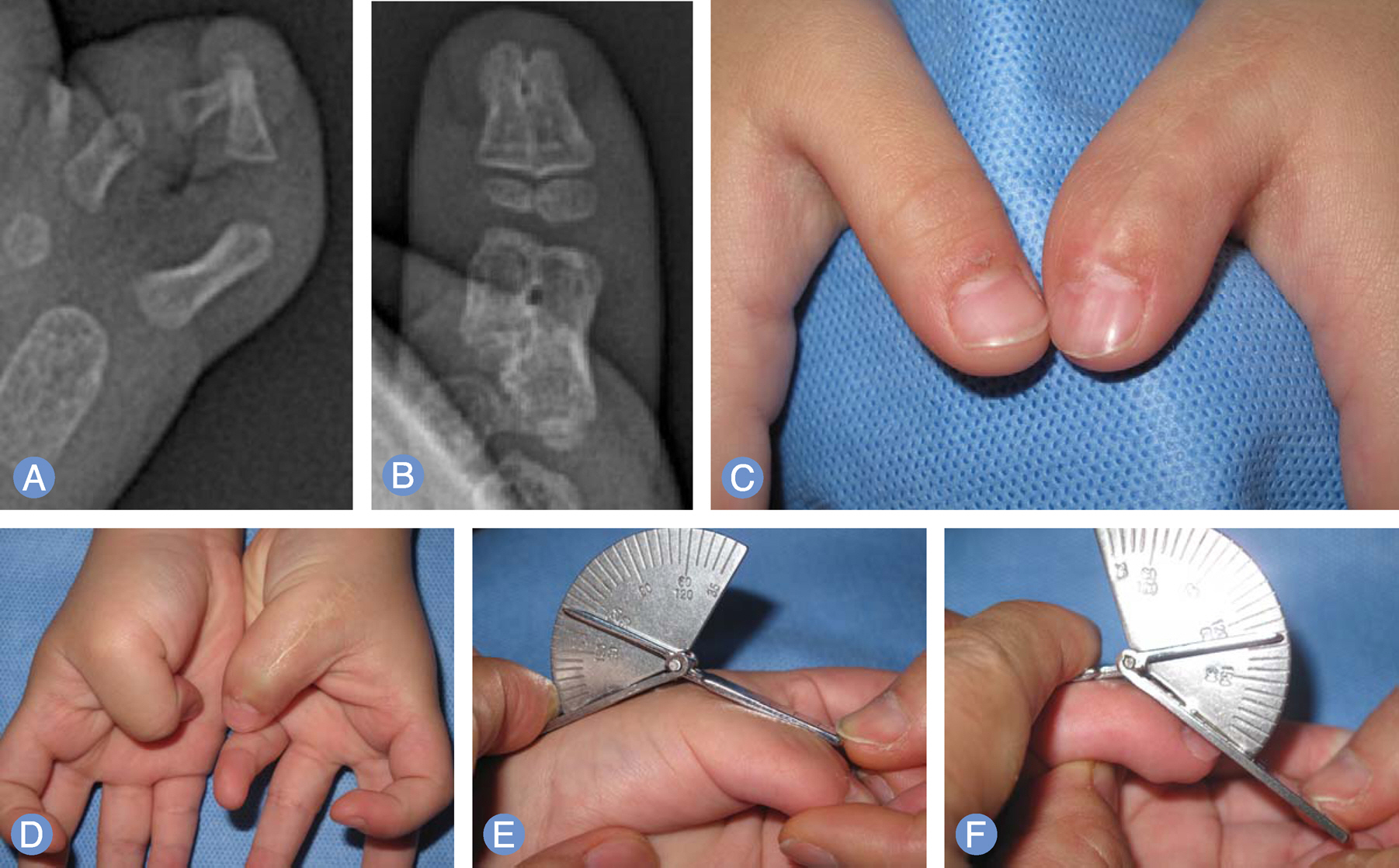J Korean Soc Surg Hand.
2013 Dec;18(4):147-154. 10.12790/jkssh.2013.18.4.147.
Modified Bilhaut-Cloquet Procedure for Convergent Type IV of Duplicated Thumb
- Affiliations
-
- 1Cheon & Woo's Institute for Hand & Reconstructive Microsurgery, W Hospital, Daegu, Korea. handwoo@hotmail.com
- KMID: 1840495
- DOI: http://doi.org/10.12790/jkssh.2013.18.4.147
Abstract
- PURPOSE
The authors applied modified Bilhaut-Cloquet procedure to convergent type of Wassel type IV duplicated thumb. In order to avoid secondary Z-deformity and dysfunction of the reconstructed thumb, the authors modified operative techniques of Bilhaut-Clopuet procedure.
METHODS
Fourteen patients received Bilhaut-Cloquet procedures to correct duplicated thumbs from October 2008 to May 2013. Five patients were balanced type and nine patients were unbalanced type. Mean age at the operation was 20.1 month-old (range, 12-52 month-old). Angular deformity, joint stability, range of joint motion and cosmetic outcome were estimated based on Tada score. Postoperative subjective satisfaction score of the parents was evaluated using a 100-points scale.
RESULTS
Mean subjective satisfaction score was 75 points at 28 months after the operation. Radiologic study showed bony union of proximal phalangeal bone and stable joint in all patients. Mean range of motion was 20 degrees in interphalangeal joint and 73 degrees in metacarpophalangeal joint. Based on Tada score, the results were good in ten patients (72%), fair in two (14%) and poor in two (14%). Seven patients who were able to follow up for a long term showed no significant difference in length of proximal and distal phalangeal bones compared to the opposite thumb.
CONCLUSION
Modified Bilhaut-Cloquet procedure can be applied not only to balanced type of convergent Wassel type IV duplicated thumb, but also to unbalanced type, that focused on functional reconstruction and cosmetic improvement.
MeSH Terms
Figure
Reference
-
1. Yen CH, Chan WL, Leung HB, Mak KH. Thumb Polydactyly: clinical outcome after reconstruction. J Orthop Surg (Hong Kong). 2006; 14:295–302.
Article2. Yasuda M. Pathogenesis of preaxial Polydactyly of the hand in human embryos. J Embryol Exp Morphol. 1975; 33:745–56.
Article3. Wassel HD. The results of surgery for polydactyly of the thumb: a review. Clin Orthop Relat Res. 1969; 64:175–93.4. Upton J. Disorders of duplication. Mathes SJ, Hentz VR, editors. Plastic surgery. 2nd ed.Philadelphia, PA: Saunders Elsevier;2006. p. 215–28.5. Tonkin MA, Bulstrode NW. The Bilhaut-Cloquet procedure for Wassel types III, IV and VII thumb duplication. J Hand Surg Eur Vol. 2007; 32:684–93.
Article6. Bilhaut M. Guerison d'un pouce bifide par un nouveau procede operatoire. Congr Fr Chir. 1890; 4:576–80.7. Hartrampf CR, Vasconez LO, Mathes S. Construction of one good thumb from both parts of a congenitally bifid thumb. Plast Reconstr Surg. 1974; 54:148–52.
Article8. Baek GH, Gong HS, Chung MS, Oh JH, Lee YH, Lee SK. Modified Bilhaut-Cloquet procedure for Wassel type-II and III polydactyly of the thumb. J Bone Joint Surg Am. 2007; 89:534–41.
Article9. Horii E, Nakamura R, Sakuma M, Miura T. Duplicated thumb bifurcation at the metacarpophalangeal joint level: factors affecting surgical outcome. J Hand Surg Am. 1997; 22:671–9.
Article10. Tada K, Yonenobu K, Tsuyuguchi Y, Kawai H, Egawa T. Duplication of the thumb: a retrospective review of two hundred and thirty-seven cases. J Bone Joint Surg Am. 1983; 65:584–98.
Article11. Park JK, Lee YK, Woo SH. Current trends of reconstructive surgery for the 173 cases of Korean duplicated thumbs based on the Iowa system. J Korean Soc Hand Surg. 2009; 14:43–50.12. Kozin SH. Deformitis of the thumb. Green DP, editor. Green's operative hand surgery. 5th ed.Philadelphia, PA: Elsevier Churchill Livingstone;2005. p. 1445–68.13. Woo SH, Seul JH. Distal thumb reconstruction with a great toe partial-nail preserving transfer technique. Plast Reconstr Surg. 1998; 101:114–9.
Article14. Sohn HB, Son D, Kim HJ, Kim JH, Han KH. Modified Bilhaut-Cloquet method for correction of bifid thumb. J Korean Soc Plast Reconstr Surg. 2006; 33:485–90.
- Full Text Links
- Actions
-
Cited
- CITED
-
- Close
- Share
- Similar articles
-
- Extended Indications of Bilhaut-Cloquet Procedure for Type III and IV of Duplicated Thumb
- Treatment of Symmetrical Thumb Polydactyly by Bilhaut-Cloquet Operation
- Modified Bilhaut-Cloquet Method for Correction of Bifid Thumb
- Clinical Experience of Central Resection and Fusion Procedure for Bifid Thumb
- Thumb Duplication: Concepts and Techniques




